Submitted:
19 September 2024
Posted:
19 September 2024
You are already at the latest version
Abstract
Keywords:
1. Introduction
2. CSES Satellite
3. Automatic Detection Method
4. Automatically Searched Plasma Perturbations during Aftershocks of the Wushi MS 7.1 Earthquake
4.1. Automatically Detected Ionospheric Perturbations
4. Discussion
5. Conclusions
Author Contributions
Funding
Data Availability Statement
Acknowledgments
Conflicts of Interest
References
- Dautermann, T.; Calais, E.; Lognonné, P.; and Mattioli, G. S. Lithosphere-atmosphere-ionosphere coupling after the 2003 explosive eruption of the Soufriere Hills Volcano, Montserrat. Geophys. J. Int. 2009, 179, 1537–1546. [Google Scholar] [CrossRef]
- Liu, J.Y.; Chen, Y.I.; Chen, C.H.; Hattori, K. Temporal and spatial precursors in the ionospheric global positioning system (GPS) total electron content observed before the 26 December 2004 M9.3 Sumatra–Andaman Earthquake. J. Geophys. Res. 2010, 115, A09312. [Google Scholar] [CrossRef]
- Kakinami, Y.; Kamogawa, M.; Tanioka, Y.; Watanabe, S.; Gusman, A.R.; Liu, J.Y.; Watanabe, Y.; Mogi, T. Tsunamigenic ionospheric hole. Geophys. Res. Lett. 2012, 39, L00G27. [Google Scholar] [CrossRef]
- Chapagain, N. Ionosphere and its Influence in Communication Systems. Symmetry 2016. [Google Scholar]
- Chen, C.H.; Sun, Y.Y.; Lin, K.; Liu, J.; Wang, Y.; Gao, Y.; Zhang, D.; Xu, R.; Chen, C. The LAI coupling associated with the M6 Luxian earthquake in China on 16 September 2021. Atmosphere 2021, 12, 1621. [Google Scholar] [CrossRef]
- Davies, K.; Baker, D.M. Ionospheric effects observed around the time of the Alaskan earthquake of March 28, 1964. J. Geophys. Res. 1965, 70, 2251–2253. [Google Scholar] [CrossRef]
- Parrot, M.; Berthelier, J.J.; Lebreton, J.P.; Sauvaud, J.A.; Santolík, O.; Blecki, J. Examples of unusual ionospheric observations made by the DEMETER satellite over seismic regions. Physics and Chemistry of the Earth 2006, 31, 486–495. [Google Scholar] [CrossRef]
- Parrot, M. Statistical analysis of the ion density measured by the satellite DEMETER in relation with the seismic activity. Earthquake Science 2011, 24(6), 513–521. [Google Scholar] [CrossRef]
- Parrot, M. Statistical analysis of automatically detected ion density variations recorded by DEMETER and their relation to seismic activity. Annales de Geophysique 2012, 55(1), 149–155. [Google Scholar] [CrossRef]
- Němec, F.; Santolík, O.; Parrot, M. Decrease of intensity of ELF/VLF waves observed in the upper ionosphere close to earthquakes: A statistical study. Journal of Geophysical Research 2009, 114, A04303. [Google Scholar] [CrossRef]
- Němec, F.; Santolík, O.; Parrot, M.; Berthelier, J.J. Spacecraft observations of electromagnetic perturbations connected with seismic activity. Geophysical Research Letters 2008, 35, L05109. [Google Scholar] [CrossRef]
- Píša, D.; Němec, F.; Parrot, M.; Santolík, O. Attenuation of electromagnetic waves at the frequency ~1.7 kHz in the upper ionosphere observed by the DEMETER satellite in the vicinity of earthquakes. Annales de Geophysique 2012, 55(1), 157–163. [Google Scholar] [CrossRef]
- Píša, D.; Němec, F.; Santolík, O.; Parrot, M.; Rycroft, M. Additional attenuation of natural VLF electromagnetic waves observed by the DEMETER spacecraft resulting from preseismic activity. Journal of Geophysical Research: Space Physics 2013, 118, 5286–5295. [Google Scholar] [CrossRef]
- Pulinets, S.A.; Legen, A.D.; Gaivoronskaya, T.V.; Depuev, V.K. Main phenomenological features of ionospheric precursors of strong earthquakes. Journal of Atmospheric and Solar - Terrestrial Physics 2003, 65, 1337–1347. [Google Scholar] [CrossRef]
- Li, M.; Lu, J.; Zhang, X.; Shen, X. Indications of ground-based electromagnetic observations to a possible lithosphere–atmosphere–ionosphere electromagnetic coupling before the 12 May 2008 Wenchuan MS 8.0 earthquake. Atmosphere 2019, 10(7), 355. [Google Scholar] [CrossRef]
- Yu, T.; Mao, T.; Wang, Y.G.; Wang, J.S. Study of the ionospheric anomaly before the Wenchuan earthquake. Chinese Science Bulletin 2009, 54(6), 1086–1092, CNKI:SUN:JXTW.0.2009-06-026(in Chinese with English abstract). [Google Scholar] [CrossRef]
- Liu, J.Y.; Chen, Y.I.; Chen, C.H.; Liu, C.Y.; Chen, C.Y.; Nishihashi, M.; Li, J.Z.; Xia, Y.Q.; Oyama, K.I.; Hattori, K.; Lin, C.H. Seismoionospheric GPS total electron content anomalies observed before the 12 May 2008 MW7.9 Wenchuan earthquake. Journal of Geophysical Research 2009, 114, A04320. [Google Scholar] [CrossRef]
- Akhoondzadeh, M.; Parrot, M.; Saradjian, M.R. Electron and ion density variations before strong earthquakes (M > 6.0) using DEMETER and GPS data. Natural Hazards and Earth System Sciences 2010, 10(1), 7–18. [CrossRef]
- Li, M.; Parrot, M. “Real time analysis” of the ion density measured by the satellite DEMETER in relation with the seismic activity. Natural Hazards and Earth System Sciences 2012, 12(9), 2957–2963. [Google Scholar] [CrossRef]
- Li, M.; Parrot, M. Statistical analysis of an ionospheric parameter as a base for earthquake prediction. Journal of Geophysical Research: Space Physics 2013, 118, 3731–3739. [Google Scholar] [CrossRef]
- Li, M.; Parrot, M. Statistical analysis of the ionospheric ion density recorded by DEMETER in the epicenter areas of earthquakes as well as in their magnetically conjugate point areas. Advances in Space Research 2018, 61, 974–984. [Google Scholar] [CrossRef]
- Li, M.; Shen, X.; Parrot, M.; Zhang, X.; Zhang, Y.; Yu, C.; Yan, R.; Liu, D.; Lu, H.; Guo, F.; Huang, J. Primary joint statistical seismic influence on ionospheric parameters recorded by the CSES and DEMETER satellites. Journal of Geophysical Research: Space Physics 2020, 125, e2020JA028116. [Google Scholar] [CrossRef]
- Li, M.; Jiang, X.; Li, J.; Zhang, Y.; Shen, X. Temporal-spatial characteristics of seismo-ionospheric influence observed by the CSES satellite. Adv. Space Res. 2024, 73, 607–623. [Google Scholar] [CrossRef]
- Li, M.; Yan, H.; Zhang, Y. Topside ionospheric structures determined via automatically detected DEMETER ion perturbations during a geomagnetically quiet period. Geosciences 2024, 14, 33. [Google Scholar] [CrossRef]
- Li, M.; Yan, H.; Zhang, Y. Inner properties of seasonal topside ionospheric structures determined via DEMETER ion perturbations. Reviews of Geophysics and Planetary Physics 2024, 55(5), 595–608. [Google Scholar] [CrossRef]
- Liu, D.; Zeren, Z.; Shen, X.; Zhao, S.; Yan, R.; Wang, X.; Liu, C.; Guan, Y.; Zhu, X.; Miao, Y.; Yang, D.; Huang, H.; Guo, F. Typical ionospheric disturbances revealed by the plasma analyzer package onboard the China Seismo-Electromagnetic Satellite. Adv. Space Res. 2021, 68, 3796–3805. [Google Scholar] [CrossRef]
- Li, M.; Wang, H.; Liu, J.; Shen, X. Two large earthquakes registered by the CSES satellite during its earthquake prediction practice in China. Atmos. 2022, 13, 751. [Google Scholar] [CrossRef]
- Huang, J.P.; Lei, J.G.; Li, S.X.; Zeren, Z.M.; Li, C.; Zhu, X.H.; Yu, W.H. The Electric Field Detector (EFD) onboard the ZH-1 satellite and first observational results. Earth Planet. Phys. 2018, 2(6), 469–478. [Google Scholar] [CrossRef]
- Yan, R.; Shen, X.H.; Huang, J.P.; Wang, Q.; Chu, W.; Liu, D.P.; Yang, Y.Y.; Lu, H.X.; Xu, S. Examples of unusual ionospheric observations by the CSES prior to earthquakes. Earth Planet. Phys. 2018, 2(6), 515–526. [Google Scholar] [CrossRef]
- Shen, X.; Zhang, X.; Yuan, S.; Wang, L.; Cao, J.; Huang, J.; Zhu, X.; Piergiorgio, P.; Dai, J.P. The state-of-the-art of the China Seismo-Electromagnetic Satellite mission. Sci. China Technol. Sci. 2018, 61(5), 634–642. [Google Scholar] [CrossRef]
- Parrot, M.; Li, M. Statistical analysis of the ionospheric density recorded by the satellite during seismic activity. In Pre-Earthquake Processes: A Multidisciplinary Approach to Earthquake Prediction Studies, AGU Monograph by Ouzounov, D., S. Pulinets, M. C. Kafatos, P. Taylor, Eds., Wiley: New York, NY, USA 2018, pp.319–328.
- Liu, D.; Zeren, Z.; Shen, X.; Zhao, S.; Yan, R.; Wang, X.; Liu, C.; Guan, Y.; Zhu, X.; Miao, Y.; Yang, D.; Huang, H.; Guo, F. Typical ionospheric disturbances revealed by the plasma analyzer package onboard the China Seismo-Electromagnetic Satellite. Adv. Space Res. 2021, 68, 3796–3805. [Google Scholar] [CrossRef]
- Li, M.; Yang, Z.; Song, J.; Zhang, Y.; Jiang, X.; Shen, X. Statistical Seismo-Ionospheric Influence with the Focal Mechanism under Consideration. Atmosphere 2023, 14, 455. [Google Scholar] [CrossRef]
- Liu, J.; Guan, Y.; Zhang, X.; Shen, X. The data comparison of electron density between CSES and DEMETER satellite, Swarm constellation and IRI model. Earth Space Sci. 2021, 8, e2020EA001475. [Google Scholar] [CrossRef]
- Yan, R.; Zhima, Z.; Xiong, C.; Shen, X.; Huang, J.; Guan, Y.; Zhu, X.; Liu, C. Comparison of Electron Density and Temperature from the CSES Satellite with other Space-Borne and Ground-Based Observations. J. Geophys. Res. Space Phys. 2019, 125, e2019JA027747. [Google Scholar] [CrossRef]
- Zhima, Z.; Hu, Y.; Shen, X.; Chu, W.; Guo, F. Storm-time features of the ionospheric ELF/VLF waves and energetic electron fluxes revealed by the China Seismo-Electromagnetic Satellite. Appl. Sci. 2021, 11, 2617. [Google Scholar] [CrossRef]
- Yang, Y.; Hulot, G.; Vigneron, P.; Shen, X.; Zhima, Z.; Zhou, B.; Magnes,W.; Olsen, N.; Toffner-Clausen, L.; Huang, J.; Zhang, X.; Yuan, S.; Wang, L.; Cheng, B.; Pollinger, A.; Lammegger, R.; Dai, J.; Lin, J.; Guo, F.; Yu, J.; Wang, J.; Wu, Y.; Zhao, X.; Zhu, X. The CSES global geomagnetic field model (CGGM): An IGRF-type global geomagnetic field model based on data from the China Seismo-Electromagnetic Satellite. Earth Planets Space 2021, 73, 45. [CrossRef]
- Spogli, L.; Sabbagh, D.; Regi, M.; Cesaroni, C.; Perrone, L.; Alfonsi, L.; Mauro, D.D.; Lepidi, S.; Campuzano, S.A.; Marchetti, D.; De Santis, A.; Malagnini, A.; Scotto, C.; Cianchini, G.; Shen, X.; Piscini, A.; Ippolito, A. Ionospheric response over Brazil to the August 2018 geomagnetic storm as probed by CSES-01 and Swarm satellites and by local groundbased observations. J. Geophys. Res. Space Phys. 2021, 126, e2020JA028368. [Google Scholar] [CrossRef]
- Gou, X.; Li, L.; Zhang, Y.; Zhou, B.; Feng, Y.; Cheng, B.; Raita, T.; Liu, J.; Zhima, Z.; Shen, X. Ionospheric Pc1 waves during a storm recovery phase observed by the China Seismo-Electromagnetic Satellite. Ann. Geophys. 2020, 38, 775–787. [Google Scholar] [CrossRef]
- Zhang, X.; De Santis, A.; Liu, J.; Campuzano, S.A.; Yang, N.; Cianchini, G.; Ouyang, X.; D’Arcangelo, S.; Yang, M.; De Caro, M.; et al. Li, X.; Fidani, C.; Liu, H.; Orlando, M.; Nie, L.; Perrone , L.; Piscini, A.; Dong , L.; Sabbagh, D.; Soldani , M.; Xiong, P. Pre-Earthquake Oscillating and Accelerating Patterns in the Lithosphere–Atmosphere–Ionosphere Coupling (LAIC) before the 2022 Luding (China) MS6.8 Earthquake. Remote Sens. 2024, 16, 2381. [CrossRef]
- De Santis, A.; Marchetti, D.; Perrone, L.; Campuzano, S.A.; Cianchini, G.; Cesaroni, C.; DiMauro, D.; Orlando, M.; Piscini, A.; Sabbagh, D.; Soldani, M.; Spogli, L.; Zhima, Z.; Shen, X. Statistical correlation analysis of strong earthquakes and ionospheric electron density anomalies as observed by CSES-01. IL Nuovo Cimento 44 C 2021, 119, 1–4. [Google Scholar] [CrossRef]
- Yang, M.; Zhang, X.; Zhong, M.; Guo, Y.; Qian, G.; Liu, J.; Yuan, C.; Li, Z.; Wang, S.; Zhai, L.; et al. Spatio-temporal evolution of electric field, magnetic field and thermal infrared remote sensing associated with the 2021 MW7.3 Maduo earthquake in China. Atmosphere 2024, 15, 770. [Google Scholar] [CrossRef]
- Xiong, C.; Lühr, H.; Yamazaki, Y. An opposite response of the low-latitude ionosphere at Asian and American sectors during storm recovery phases: Drivers from below or above. J. Geophys. Res. Space Phys. 2019, 124, 6266–6280. [Google Scholar] [CrossRef]
- Ruzhin, YuYa; Sorokin, V.M.; Yashchenko, A.K.; Physical mechanism of ionospheric total electron content perturbations over a seismoactive region. Geomag. Aeron. 2014, 54 (3), 337–346. [CrossRef]
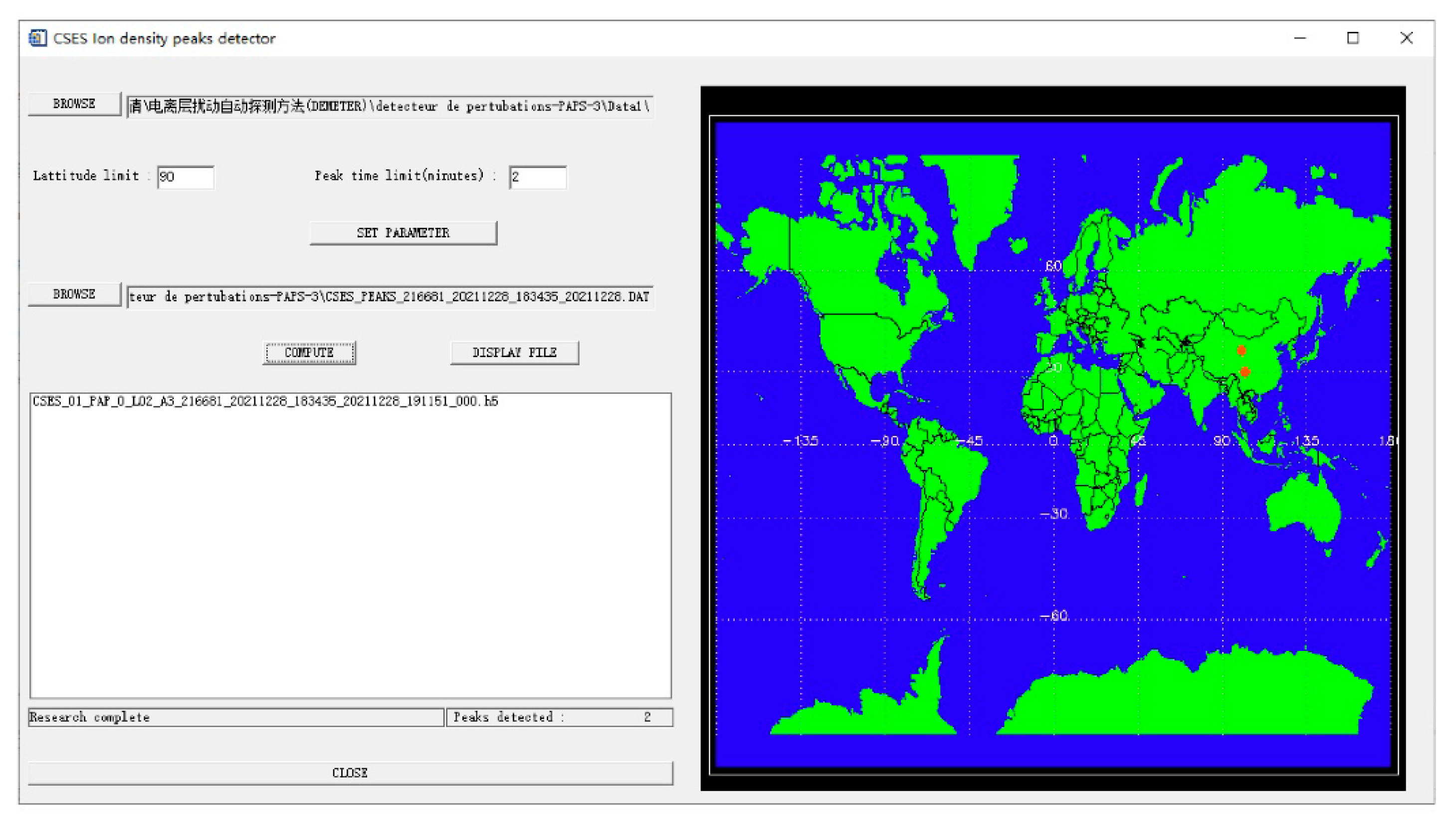
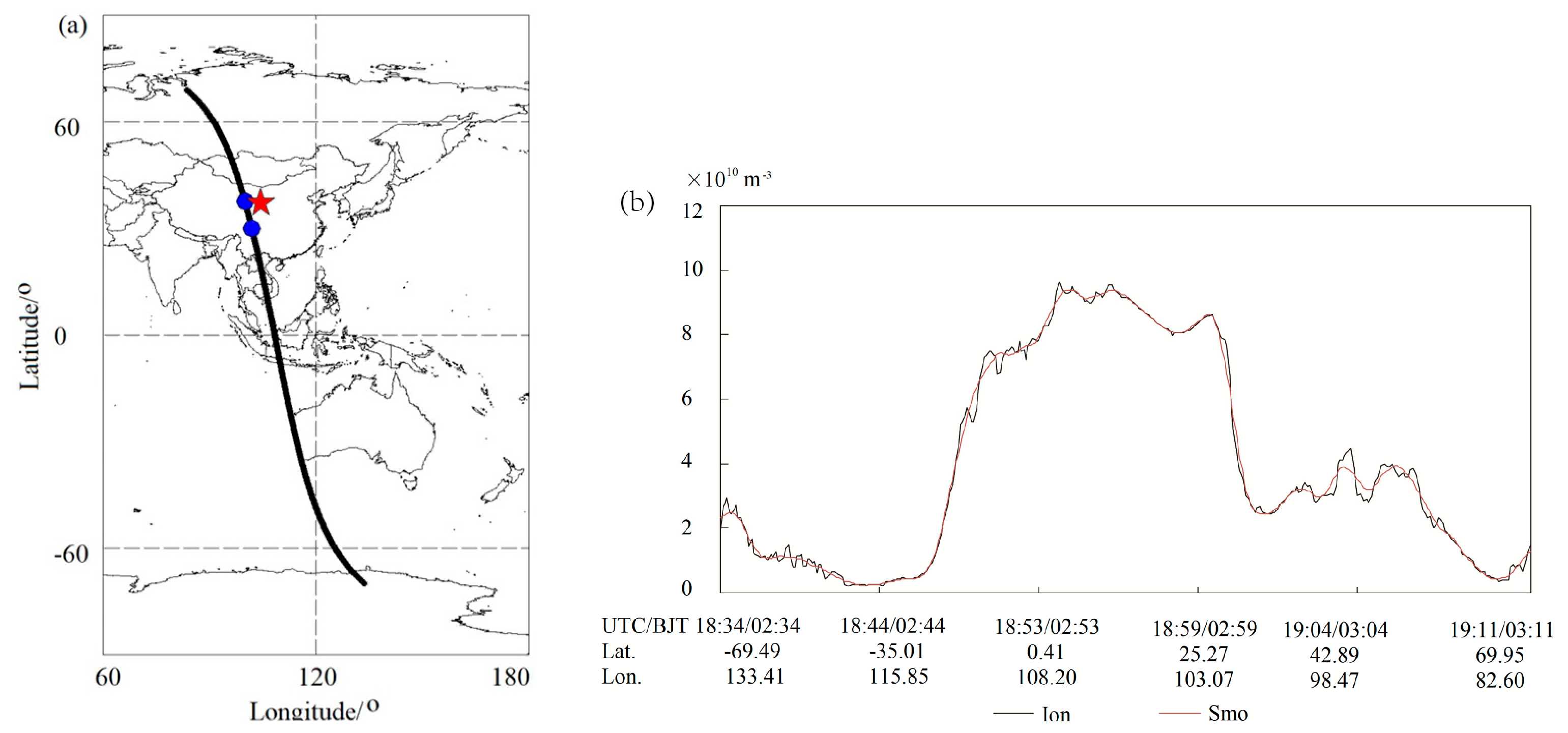

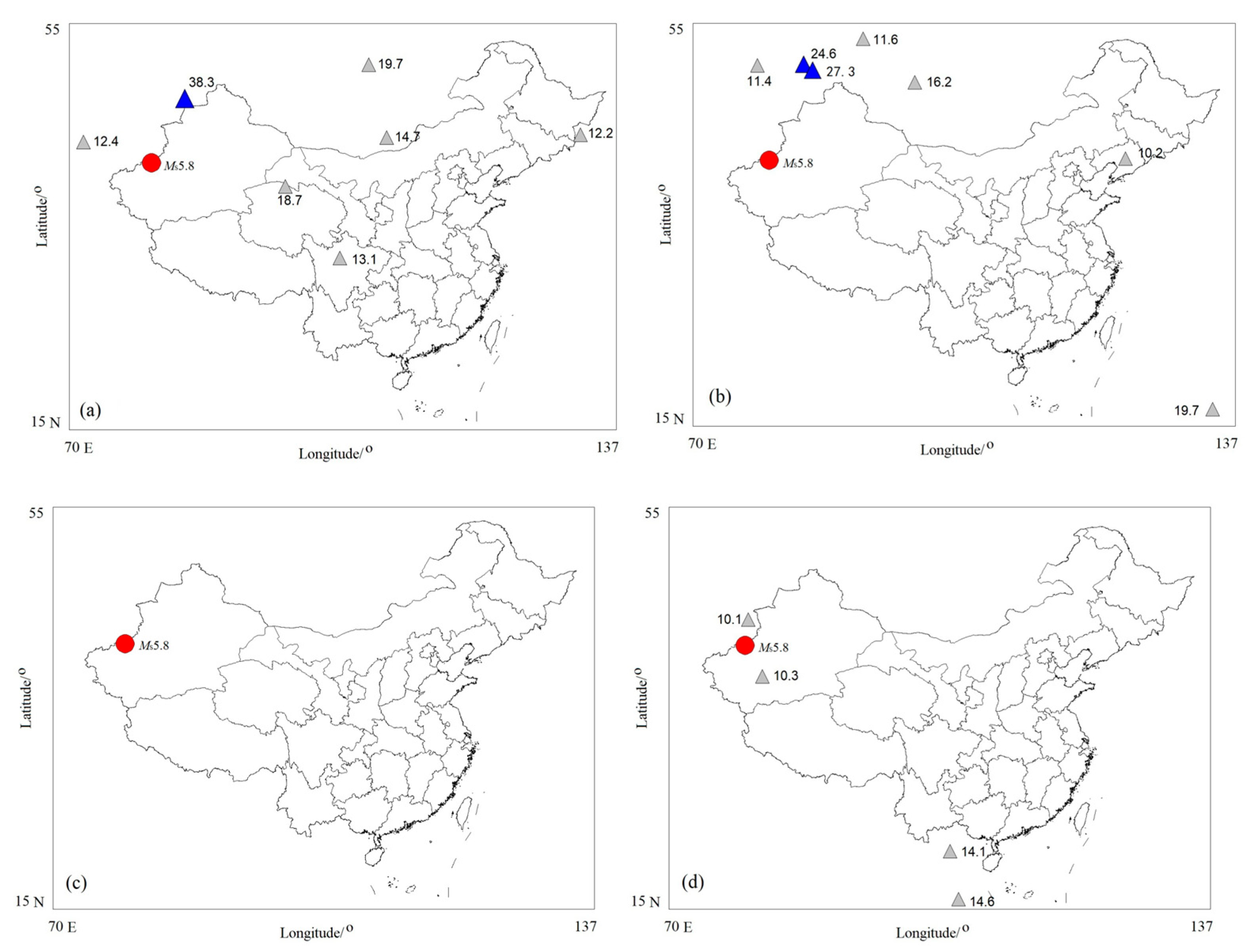
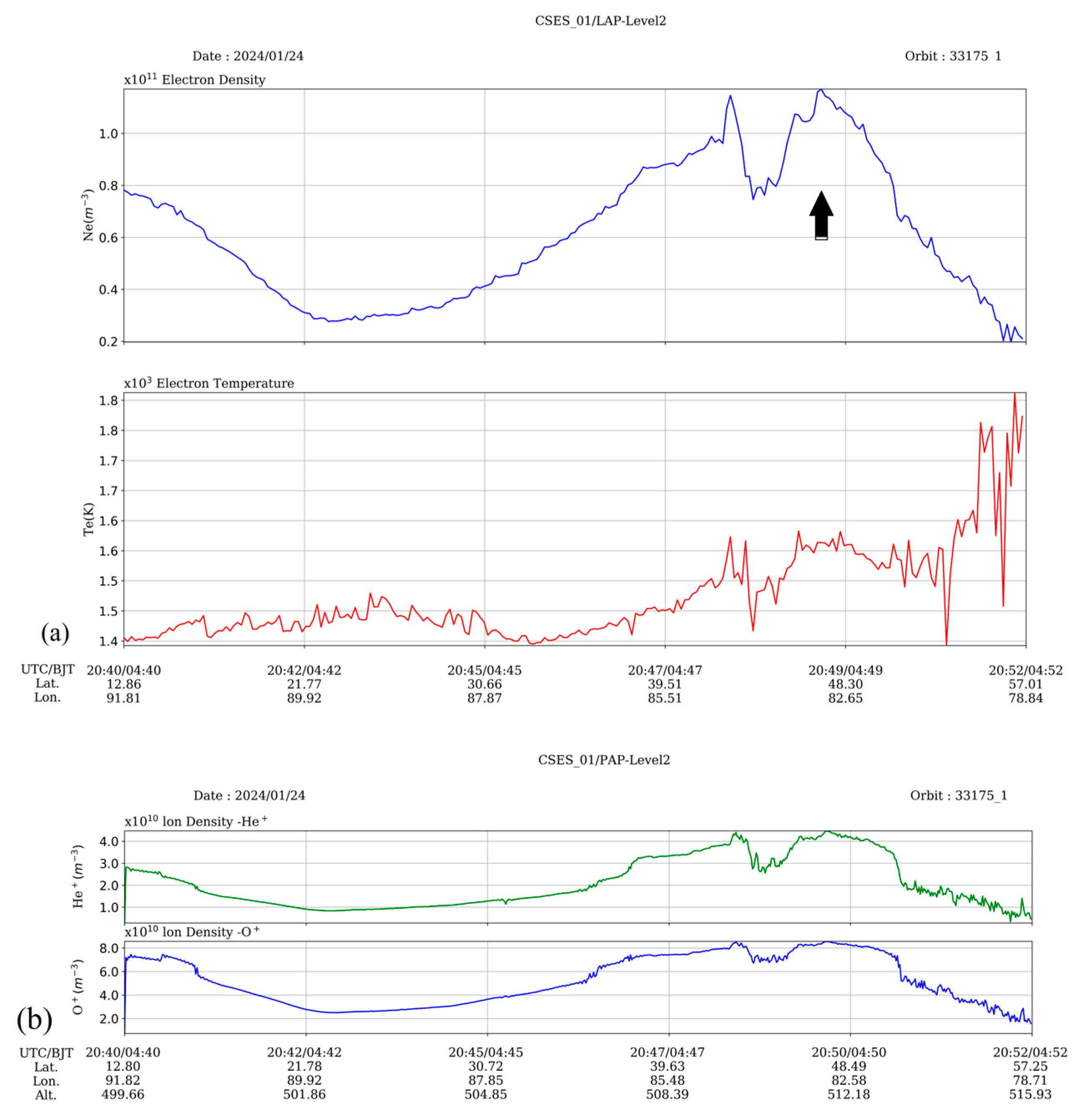
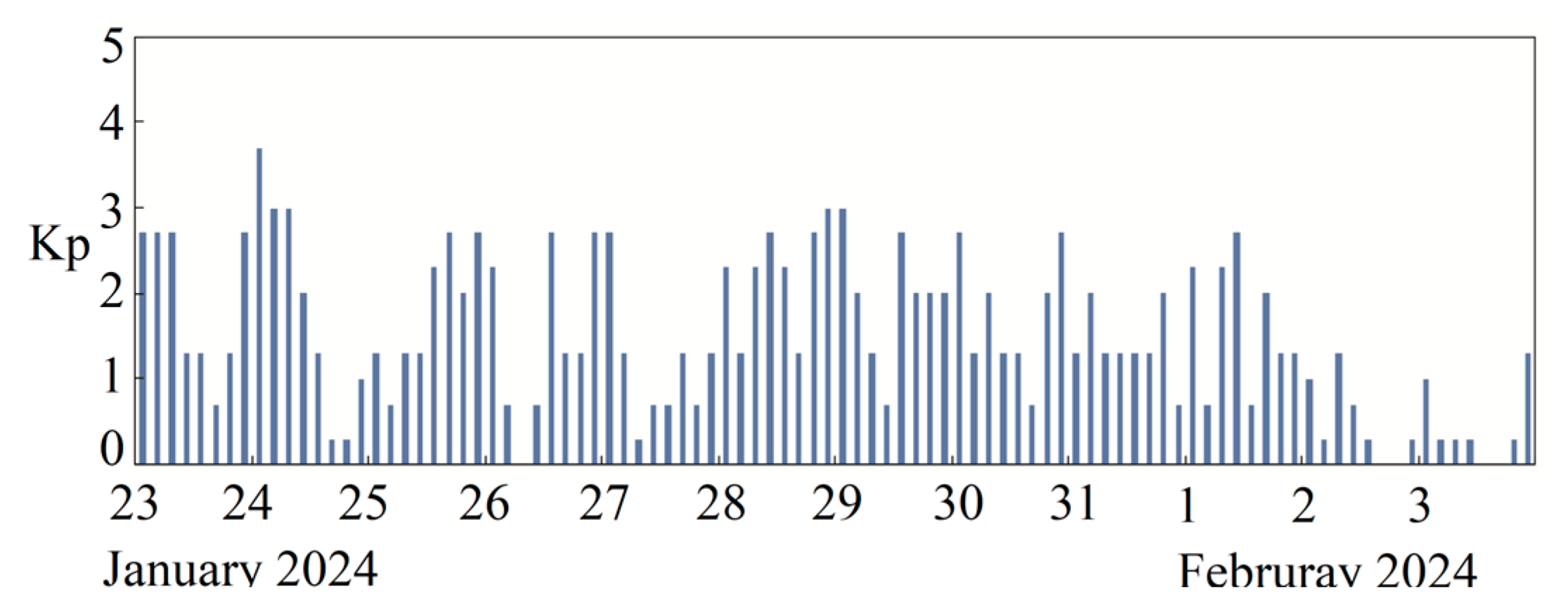
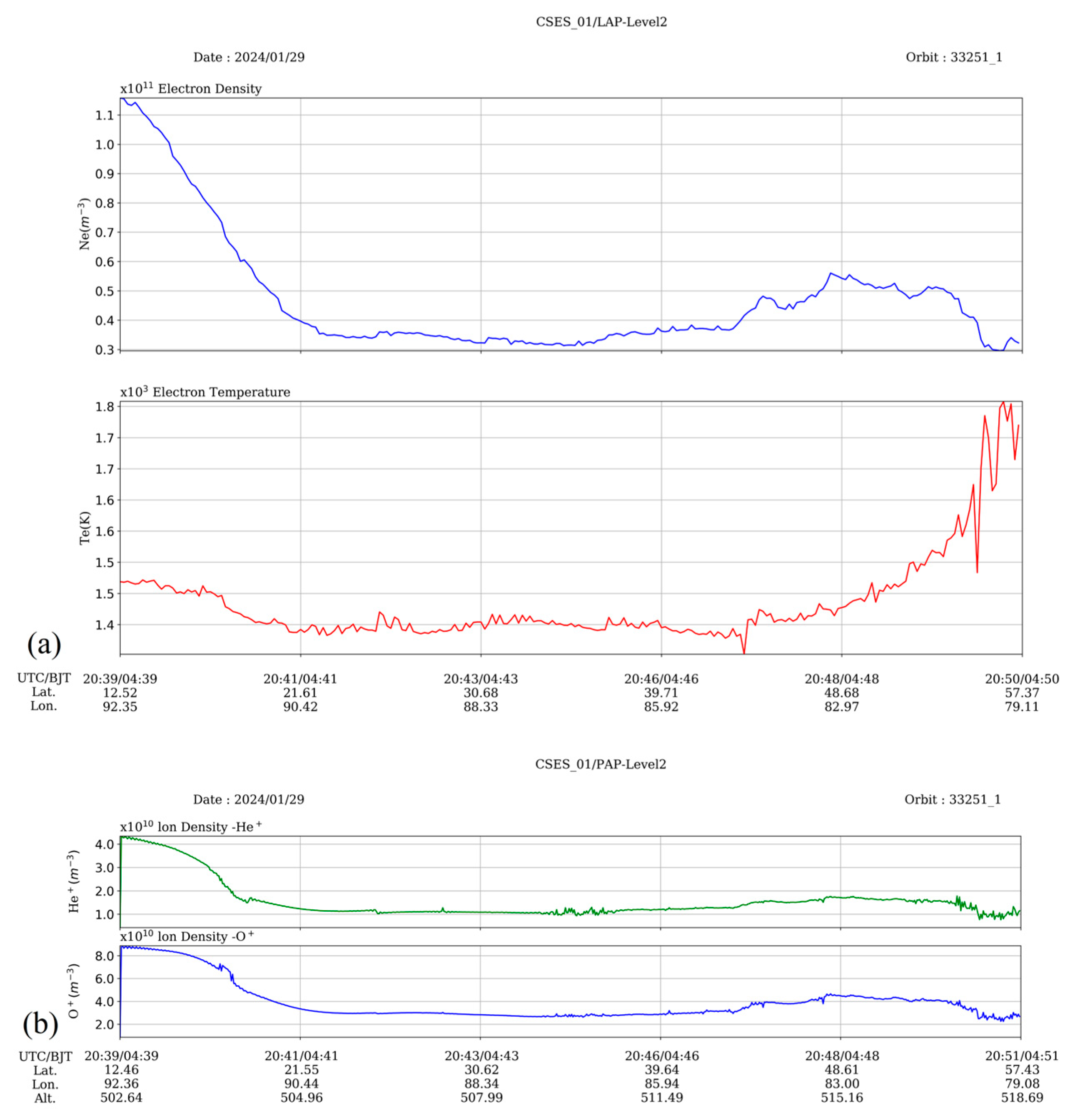
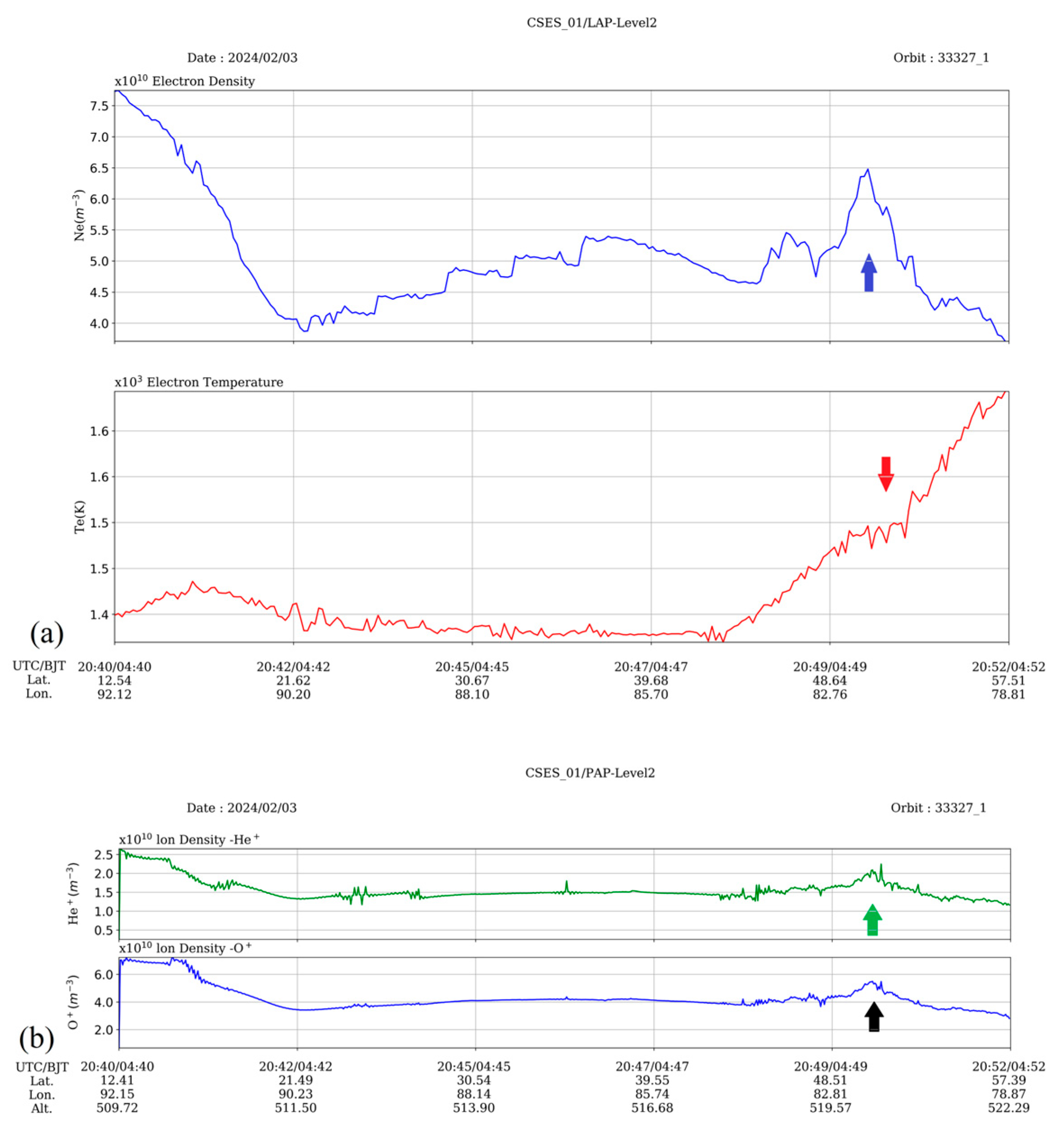
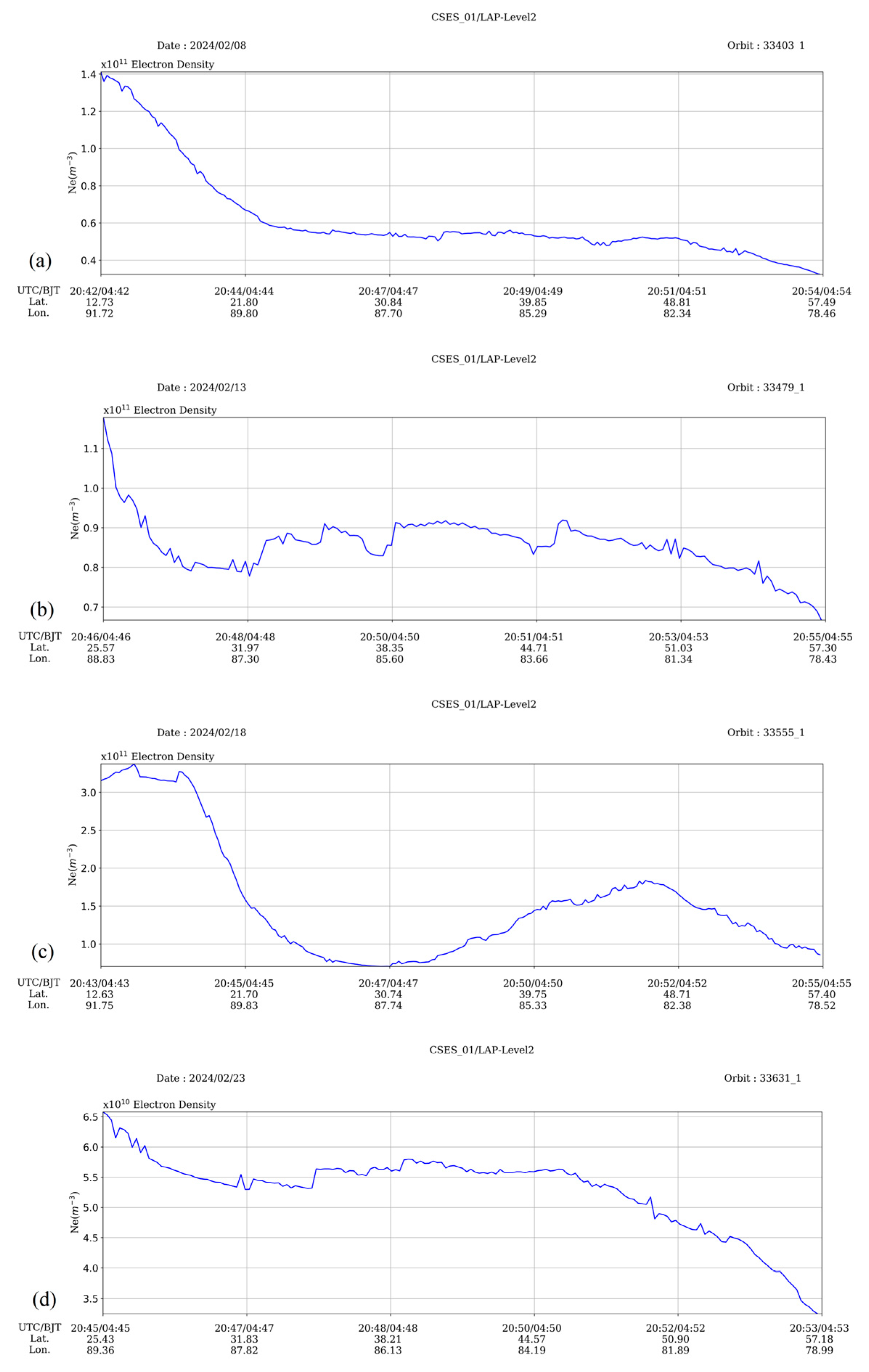
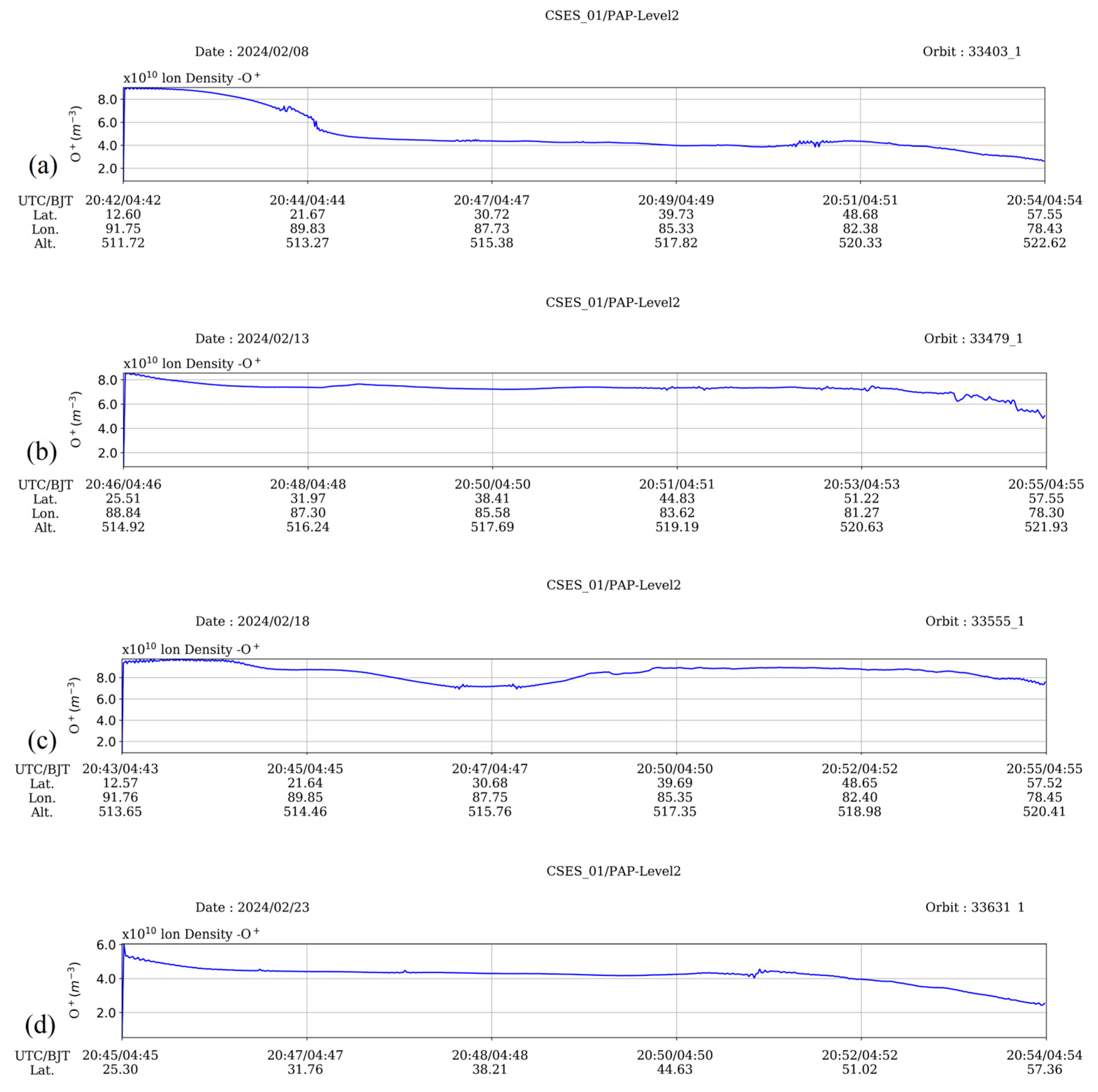
| P1 P2 | ||
| Date (y m d) | 2021 11 28 | 2021 12 28 |
| Time (h m s ms) | 19 3 11 404 | 19 1 11 404 |
| Orbit Suborb |
21668 1 |
21668 1 |
| Latitude (°) | 37.6597 | 30.1204 |
| Longitude (°) | 99.9981 | 101.940 |
| BkgdIon (cm-3) | 32710.7 | 30500.9 |
| Amplitude (cm-3) | 42544.1 | 31740.9 |
| Trend | Increase | Increase |
| Percent (%) | 30.1 | 4.1 |
| Time_width (m s ms) | 1 48 0 | 1 18 0 |
| Extension (km) | 769 | 557 |
| Time/yyyymmdd hh-mm-ss | Latitude/° | Longitude/° | Magnitude/MS | Depth/km |
| 20240123 02-09-05 20240123 02-42-33 20240123 03-36-46 20240123 07-19-25 20240123 09-18-41 20240124 04-38-12 20240125 06-21-48 20240126 04-01-28 20240130 06-27-40 20240224 06-58-55 20240225 12-14-59 |
41.26 41.33 41.11 41.21 41.19 41.06 41.08 41.29 41.15 41.12 41.15 |
78.63 78.70 78.66 78.71 78.84 78.65 78.55 78.83 78.67 78.54 78.41 |
7.1 5.2 5.3 5.2 5.2 5.7 5.2 5.6 5.7 5.3 5.8 |
22 14 20 15 10 10 15 18 10 10 11 |
| Pe1 Pe2 Pi2 | |||
| Date (y m d) | 2024 1 24 | 2024 2 3 | 2024 2 3 |
| Time (h m s ms) | 20 49 48 975 | 20 50 28 465 | 20 50 26 464 |
| Orbit Suborb |
33175 1 |
33327 1 |
33327 1 |
| Latitude (°) | 47.7407 | 50.4960 | 50.3701 |
| Longitude (°) | 82.8527 | 82.0411 | 82.0913 |
| BkgdIon (×106cm-3) | 82726.0 | 51063.0 | 42276.4 |
| Amplitude(×106cm-3) | 114377.0 | 63603.4 | 53827.6 |
| Trend | Increase | Increase | Increase |
| Percent (%) | 38.3 | 24.6 | 27.3 |
| Time_width (m s ms) | 1 30 0 | 1 9 0 | 1 12 7 |
| Extension (km) | 639 | 489 | 510 |
Disclaimer/Publisher’s Note: The statements, opinions and data contained in all publications are solely those of the individual author(s) and contributor(s) and not of MDPI and/or the editor(s). MDPI and/or the editor(s) disclaim responsibility for any injury to people or property resulting from any ideas, methods, instructions or products referred to in the content. |
© 2024 by the authors. Licensee MDPI, Basel, Switzerland. This article is an open access article distributed under the terms and conditions of the Creative Commons Attribution (CC BY) license (https://creativecommons.org/licenses/by/4.0/).





